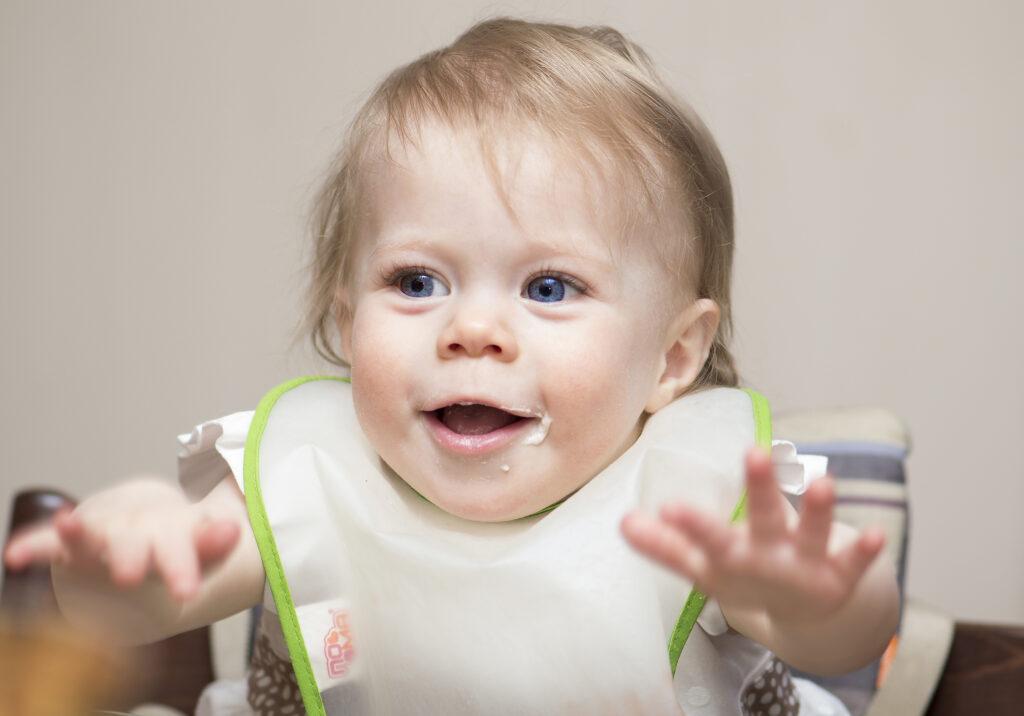
Most of us are aware of the American Academy of Pediatrics (AAP) feeding recommendations. The AAP recommends that parents “introduce solid foods around 6 months of age.” The important word that parents and providers often miss is “around.” Honestly, some babies just aren’t quite ready for solid foods at exactly 184 days old.
Hence, the calendar is not a reliable indicator that the baby is ready for solid foods. Instead, we should look for observable clues in three broad categories … and we should note some subtle things that most adults aren’t aware of.
Oral development
Development can be the acquisition of a reflex or skill. In terms of oral development, at around 6 months of age, babies have the skill to move food around in their mouths. Less skill is required for managing pureed foods, whereas more skill is required for semi-solid, or solid foods. Which type of food they start with is often a matter of the baby’s or the parent’s personal preference.
However, oral development can also be the loss of reflexes. Babies can’t handle solid foods until they have lost the rooting reflex and tongue extrusion reflex (where they push their tongue out). And the gag reflex should be less intense.
Motor skills
Motor skill simply means moving by using one’s muscles.
An experienced occupational therapist who once attended one of my courses taught everyone in the room a little jingle we had never heard before. She said, “proximal stability to achieve distal mobility.” Let’s think about that!
You’ve heard of “core strengthening,” right? It’s a similar principle. When larger, proximal “core” muscles have strength and stability, it’s easier to move distal body parts. Distal muscles, being further from the center, include the tongue and other oral muscles.
Whether the baby is breastfeeding or eating solids, this principle applies.
Gross motor skills
Gross motor skills involve using the larger muscles. The baby should be able to sit well in a highchair or booster chair. When they are ready for solids, their head, neck, and trunk muscles should be strong enough to provide good stability.
Better proximal stability facilitates distal mobility of the intraoral and extraoral muscles when breastfeeding. But the same is true when taking solid foods. Whether it’s ingesting a piece of banana on their mother’s finger, accepting strained peaches from a spoon, or picking up a cheerio, the involved distal muscles do better when proximal muscles are strong and stable.
Fine motor skills
Fine motor skills involve movement using smaller muscles. When babies use their lips and tongue to taste and feel objects (including food), they’re using fine motor skills. Offering solid food gives them a chance to use these muscles, and to explore the food — not necessarily consume it.
A baby who can pick things up between their finger and thumb (called the pincer grasp) is also using fine motor skills. Solids should not be offered until a baby is willing and able to chew foods. And, by about 6 months, a baby should be able to drink from a cup. If they can do these tasks, they’re ready for solids.
“Interest”
Around 5 or 6 months of age, babies start to show interest in having table food. They often reach out to grab the food. I try to caution parents that this might be just a “monkey see, monkey do” behavior. Or it may be true interest in consuming the food.
You might start by letting the baby drink some water from the cup you’re using. Then, you can see if they are truly interested in consuming the contents, or just doing what everyone else is doing. If it’s the latter, try giving some unbreakable cups or bowls to play with.
Similarly, sometimes kids express interest by putting a “deprived” look on their faces. It’s as if they’re saying, “Hey! What about me?”
So is the baby ready for solid foods?
I’ve tried to list some commonly-observable clues. Certainly, the baby’s digestive tract needs to be ready, but we can’t see inside there! That’s why we rely on recommendations from public health authorities, and have an understanding of breastfeeding after complementary foods are offered.
However, watching these visible signs of readiness is helpful. Remember, though: Exhibiting just one of these signs is not enough to indicate a readiness for solid foods. Ideally, the baby should show at least three signs of readiness.
Can you think of anything I omitted? Please share your thoughts in the comments below.
